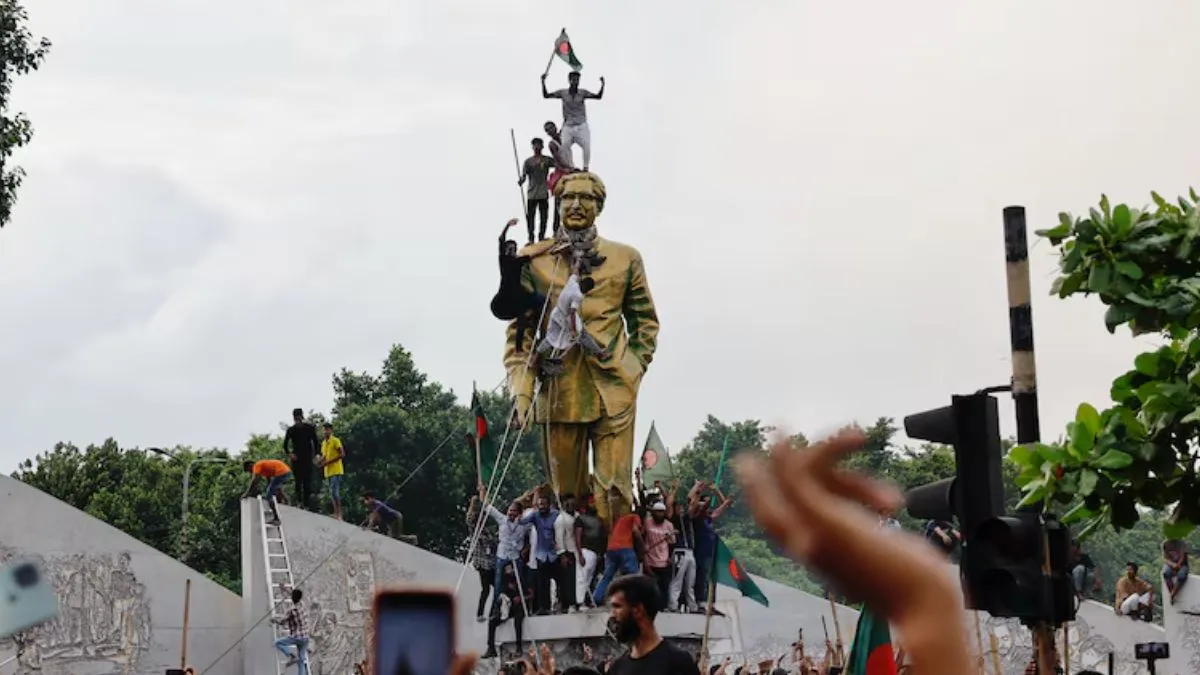- By Supratik Das
- Mon, 30 Jun 2025 08:44 AM (IST)
- Source:JND
Bangladesh's interim government announced August 5 as Mass Uprising Day to mark the historic anti-government street demonstrations that led to the resignation and dramatic exit of former Prime Minister Sheikh Hasina last year. The announcement was made following a meeting of the Council of Advisers, presided over by interim leader and Nobel Peace Prize laureate Muhammad Yunus, in Dhaka's Tejgaon on Sunday.
During the same meeting, the interim government revoked its previous decision to declare August 8 as New Bangladesh Day. August 8 was the day Yunus formally became Chief Adviser following the resignation of Hasina and her departure to India in the wake of weeks of violent protests. "There will be no special celebration on August 8," Yunus's press secretary Shafiqul Alam, announced in a formal statement. Rather, the interim government will celebrate July 16 as July Shaheed Day and August 5 as Mass Uprising Day.
Hasina's Fall After 15 Years In Power
Sheikh Hasina, who initially became Bangladesh's Prime Minister in 1996 and then came back to power in 2009, was confronted by escalating fury over human rights violations, charges of authoritarianism, and a controversial quota system in government employment. The turning point arrived in July 2024 when students organized countrywide protests calling for an end to the 30% quota for descendants of 1971 war heroes. Opponents claimed the quota was the least expected move by the government, as it helped supporters of Hasina's Awami League. What began as a student uprising soon turned into an anti-government mass uprising as it gained sympathy from common people, celebrities, and even factions from the business community. As per interim chief Muhammad Yunus, the protests and those that followed resulted in the deaths of some 1,500 people, with an estimated 3,500 forcibly disappeared during Hasina's tenure. This ranks among Bangladesh's bloodiest periods of civil unrest in recent times. Last year on August 5, when the violence was mounting, Hasina quit and escaped from her official residence, the Ganabhaban, which was later breached by protesters.
The last few days witnessed police stations, offices of the ruling party and residences of Awami League leaders targeted in 39 districts. At least 13 policemen were bludgeoned to death in Sirajganj, while government offices, hospitals, and garment industries were torched. In a bid to get the violence under control, the government declared an indefinite nationwide curfew and suspended internet services, paralysing communications and social media.
Timeline: Sheikh Hasina’s Rule
• 1996 (June): Sheikh Hasina becomes Prime Minister for the first time after her Awami League wins the general elections.
• 2001 (July): Hasina’s first term ends. The Awami League loses the election to the Bangladesh Nationalist Party (BNP).
• 2009 (January 6): Hasina returns as Prime Minister after the Awami League’s landslide victory in the December 2008 elections.
• 2009 (February): Bangladesh Rifles mutiny: Over 70 people killed in a revolt by a paramilitary force. Hasina’s government quells the rebellion.
• 2011 (June): The 15th Amendment to the Constitution abolishes the neutral caretaker government system for overseeing elections — a turning point that sparks opposition concerns about free and fair polls.
• 2013 (February): Shahbagh Movement: Mass protests demand the death penalty for 1971 war criminals. The movement strengthens Hasina’s popularity among secular groups.
• 2013 (October) Rana Plaza tragedy: More than 1,000 garment workers die when a building collapses, putting global spotlight on Bangladesh’s garment industry and labour standards.
• 2014 (January 5): Hasina wins re-election amid an opposition boycott. BNP calls it a farce. Hasina begins her second consecutive term.
• 2015 (January): Violent political unrest erupts as the opposition demands new elections under a neutral caretaker setup.
• 2018 (December 30): Awami League sweeps the polls again with allegations of widespread vote-rigging. Hasina secures a third straight term.
• 2020 (March): COVID-19 pandemic hits Bangladesh. Lockdowns fuel economic distress but the garment sector remains resilient.
• 2021 (December): The US imposes sanctions on the elite Rapid Action Battalion (RAB) for alleged extrajudicial killings and enforced disappearances under Hasina’s watch.
• 2022: Bangladesh posts strong GDP growth of 7.2%. However, income inequality widens sharply.
• 2024 (January): Hasina wins a fourth consecutive term after an opposition boycott of national elections.
• 2024 (July): Massive student protests erupt over the reintroduced quota system for government jobs. Demonstrations spread nationwide, turning into an anti-government uprising.
• 2024 (August 5): After weeks of violent clashes that leave over 1,500 dead, Hasina resigns and flees Bangladesh. Protesters stormed the Prime Minister’s residence in Dhaka.
ALSO READ: Bangladesh Hindu Woman Rape: Khaleda Zia Party Leader Arrested After Viral Video Sparks Outrage
Muhammad Yunus, the renowned economist and Grameen Bank founder, now leads the interim government responsible for restoring stability and organizing new elections. Although there will not be any official ceremonies to mark the day that Yunus took office, the caretaker government maintains that observing Mass Uprising Day will be a tribute to those who perished struggling for democracy and justice.

